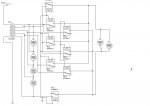I was reading cooldude's post on dimming etc around the house, and the talk got into 'sine wave' dimming & all that, I didn't want to hijack his thread, but...
could you use a (cheap) audio amplifier, say 100w, to drive 12v halogen lamps? they dont operate at very high output voltages (when not dealing with transients)
then you could generate a sine wave, vary the amplitude and have silent dimming. no harmonics from chopped AC etc.
you would have to limit the amplitude of the sine-wave, as the voltage output would be relative to the power being driven. perhaps as a bespoke dimming solution?
or am I missing something here?
could you use a (cheap) audio amplifier, say 100w, to drive 12v halogen lamps? they dont operate at very high output voltages (when not dealing with transients)
then you could generate a sine wave, vary the amplitude and have silent dimming. no harmonics from chopped AC etc.
you would have to limit the amplitude of the sine-wave, as the voltage output would be relative to the power being driven. perhaps as a bespoke dimming solution?
or am I missing something here?

